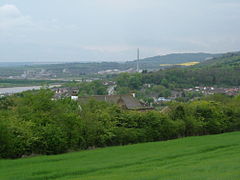- Cuxton
-
Coordinates: 51°22′30″N 0°27′00″E / 51.375°N 0.450°E
Cuxton
Looking south, Cuxton seen from Ranscombe Farm. In the distance is the cement works at Halling
 Cuxton shown within Kent
Cuxton shown within KentOS grid reference TQ709665 Parish Cuxton Unitary authority Medway Ceremonial county Kent Region South East Country England Sovereign state United Kingdom Post town ROCHESTER Postcode district ME2 Dialling code 01634 Police Kent Fire Kent Ambulance South East Coast EU Parliament South East England UK Parliament Rochester and Strood List of places: UK • England • Kent Cuxton is a village in the unitary authority of Medway. It lies on left bank of the River Medway in the North Downs. It is served by the A228, and Cuxton railway station on the Medway Valley Line between Strood and Maidstone. A low valley leads up from the river to the hamlet of Lower Bush.
Contents
History
Archaeological evidence suggest the first human occupation was around 200,000 years ago. A hoard of 196 handaxes from the Acheulian era was excavated in 1962. This is now displayed in the British Museum. The name is believed to have developed from "Cucula's stone".[1]
Remains of a Roman villa was found under the church yard. The Saxons occupied the village and it became known as Cuckelstane. The church and parish was given by Æthelwulf, King of the West Saxons to the Cathedral church of St. Andrew, Rochester. The church contains much Norman architecture, and is unusual as it lies on a southeast northwest axis. This gave rise to the rhyme, He that would see a church miswent / Let him go to Cucklestane in Kent.
In Tudor times the principal house in the village was Whorne's place erected on the river, by Sir William Whorne, Lord Mayor of London in 1487. This was later owned by Sir Joseph Levinson (1556-1615) the privateer. This was taken over by the Mashams, strong royalists who moved on to the Mote in Maidstone. Only an outlying granary survived in 1971.
The only other manor in Tudor Cuxton was that of Beresse or Beresh, now known as Bush. It doesn't survive.
In 1610, William Laud was rector of Cuxton, he later became Archbishop of Canterbury under Charles I, he was executed by the puritans in 1645 because of his strong royalist loyalties.
In Upper Bush there are four houses dating from 14th century and a Tudor Kentish Yeoman's house.[2] A tin chapel from Cuxton was dismantled and re-erected at the Museum of Kent Life, Sandling.
Ranscombe Farm
Main article: Ranscombe FarmRanscombe Farm is a plantlife nature reserve, country park and working farm. Part of the site is included in the Cobham Woods Site of Special Scientific Interest, and the whole farm is within the Kent Downs Area of Outstanding Natural Beauty.
Industry
References
External links
 Media related to Cuxton at Wikimedia Commons
Media related to Cuxton at Wikimedia CommonsTowns and villages in the Unitary authority of Medway in Kent, England Allhallows · Borstal · Brompton · Chatham · Chattenden · Cliffe · Cliffe Woods · Cooling · Cuxton · Frindsbury · Frindsbury Extra · Gillingham · Halling · Hempstead · High Halstow · Hoo St Werburgh · Isle of Grain · Lordswood · Rochester · Rainham · Rainham Mark · St Mary Hoo · St Mary's Island · Stoke · Strood · Twydall · Upnor · Wainscott · Walderslade · WigmoreList of places in Kent Categories:- Medway
- Villages in Kent
- Civil parishes in Kent
Wikimedia Foundation. 2010.


